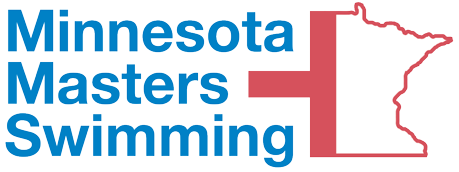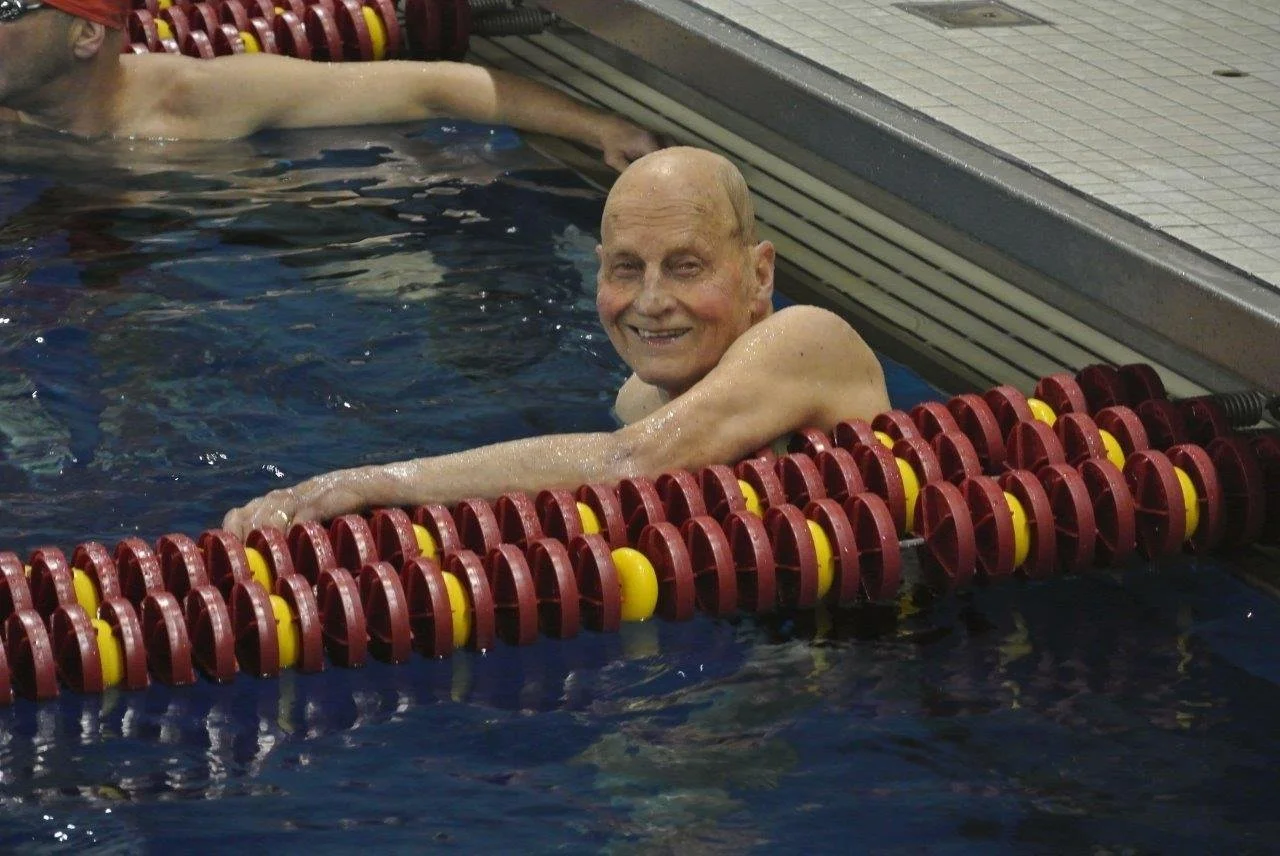Ray Hakomaki
Ray Hakomaki’s illustrious swimming career began at the age of 15 as a high school freshman in Gilbert, Minnesota in a 20 yard 4-lane pool. How does one condense the next 79 years of swimming into a 500 word story? Let’s start by wishing Ray a Happy 93rd Birthday, (the ceremony for his induction in the Hall of Fame was on his birthday, October 25, 2014).
After a successful high school career, the University of Minnesota recruited him by offering a part time job that paid with meals. Workouts at that time were 1500 yards and some kicking with wooden kickboards. Ray was drafted into the Army Air Force after graduation and was based in Oahu. There he swam on a military swim team and continued his success. Returning stateside after discharge, Ray enrolled in school again for a Masters degree and then took a job with General Mills that required a lot of travel.
Motel pool swimming wasn’t cutting it, so after a big weight gain, and realization that he was in bad physical shape, he decided to join the Gopher Swim Club in 1970. “Pool 15” in Cooke Hall became his new swimming home. Workouts were more rigorous than college, 2500 yards/day 5 or 6 days/week. In 1972 he was challenged to swim in a Masters Meet in San Mateo, California. The memory of beating Doc Councilman in the 50 free with a time of 26:15 at age 52 is still vivid in his mind.
Over the next 40 years, Ray continued to workout and compete on a regular basis. He has become our most decorated Minnesota Masters Swimmer with 407 Top Ten Individual Times, 56 of those first places. He has been on 6 Top Ten Relays. Nationally he holds 14 current records, and has been named an All American Pool All Star 23 times. FINA has him listed twice in the All Time performers list. With all these honors, comes lots of pool practice time, and Ray welcomed the bigger, cooler University Aquatic Center after many years in Cooke Hall. A recent press release indicated the Natatorium has had 5 million visitors since it was built in 1990. We wonder how many of those visits were Ray’s?
Ray’s favorite event was always the 50 free. He feels anything longer than 100 is a distance event. He has competed at many National events through the years, and has kept track of times that continued to stay low, even as the birthdays added on. 14 years after beating Doc, he set a national record in the 50 free with a 26.49 (age 66.) When venturing into distance events, sometimes the results were not so record setting. In 1973 he was DQed in a 400 IM for doing a little bit of inappropriate flutter kicking.
Some of Ray’s more famous comments:
“Swimming has been the ideal sport for me. Being supported by the water gives a shock free environment for exercise that can be done for a lifetime.”
“I appreciate all the people I have met, all with the love of swimming; male or female, yet with so many diverse backgrounds, career paths and education disciplines."
“You compete and yet you share information on how to improve your performance. You learn discipline of having a good habit, showing up for workouts rain or shine.”
“I attribute my swimming workouts for getting my body and heart into good condition. I now weigh about 155 pounds, which was my college weight.”
Ray’s love and devotion to swimming is obvious. He took the time to respond in much more detail to the Hall of Fame questionnaire.
1. Do you have any high school swimming stories? My high school coach (an ex-diver) was knowledgeable about swim fundamentals and could teach and evaluate strokes. Our workouts were moderate, fitting the hour pool time available. We competed against Range towns; Hibbing and Virginia being the strong competition. They were very strong statewide because of the shortage of pools in the Twin Cities area. I swam in three State Meets, twice as a team member and once solo. The school was so short of money that they gave me a $20 bill and had me hitch a ride with my math teacher. I placed 15th in team scores.
2. Can you give us more background about your time at the University of MN? The University of Minnesota swim coach (Niels Thorpe) recruited me by offering me a part-time job. It was an opportunity to work three hours a day (bussing dishes at the University Hospital) for three meals a day. This was enough to enable me to register in Aeronautical Engineering. My swim workouts were to swim 1500 yards crawl, kicking with a board (wooden) and some other work on strokes. We did some sprint training but we did not have interval training. Post-graduation (December1943) I was drafted into the Army Air Force, had basic training and then some assignments at various Air Force bases. Late in 1945 I was assigned to Hickman Field in Oahu, Hawaii. While there, the military initiated an athletic program (for troop morale) called the Pacific Olympics, and Oahu was chosen for the swimming program. I joined the Hawaii team. We trained for about three weeks ay Schofield Barracks. I swam anchor on the winning medley relay team.
3. What happened after the Service? After discharge from the service I went back to school to get my Masters degree. I then worked at General Mills on jobs that required a lot of travel, which meant swimming in motel pools. My weight climbed from about 160 pounds to 205 pounds and I was in very bad physical shape. I decided to start swimming again, which I did by getting a locker at Cooke Hall and swimming on Pool 15. I joined the Gopher Swim Club I believe in 1970 and started working out with the youngsters. Jean Freeman was our first coach. Her workouts and those of subsequent coaches were quite rigorous, usually a long warm up and then sets of 5 or 10 intervals with different strokes. The workouts were usually 2500 yards total, and I swam for 5 or 6 days each week. In 1972 John Bergman and Marty Knight urged me to join them to swim in the third Masters Meet, a short course meet hosted by the San Mateo Masters. Each of us came home with a first place finish. I had the pleasure of beating Doc Councilman in the 50 Free with a time of 26:15. He gave up sprinting to swim the English Channel. The same year I swam a 29:12 in the long course 50 Free at Bloomington, Indiana. In 1976 I joined the Northern Shores Swim Club, coached by the very capable and hard driving Tom Hodgson. As a team we swam very well at national meets.
4. Tell us about your logbook? I continued working out and competing well for 35 years. I kept logbooks on my workouts until 2013, showing the gradual reduction of work out intensity with the years. Most of the effort was self-motivated for health maintenance reasons, but also motivated by the competitive urgings of my many pool friends. Early on I could swim about 2500 yards of warm-up and interval sets. With age this was reduced to about 1500 yards.
5. What was your favorite race and tell us about 1976? My best race was the 50-yard Free at Fort Lauderdale, Florida short course. Unfortunately I cannot find my recording of the time among my stacks of files. In 1976 at the St. Louis long course meet I won all five events that I had entered.
6. Did you swim in any international meets? In 1977 I swam in a meet in an old Olympic pool in Helsinki, Finland. I swam three events and won them all. The 50 Free in 30.0, the 50 Breast in 45.1 and the 50 Fly in 42.8.
7. What happened at the Fort Pierce, Florida meet? In 1986 at the Fort Pierce meet I won all six events I had entered and set a national records of 26.49 in the 50 Fr.
8. Tell us some of your funniest swim stories? The funniest swim memory was during a long course meet in California in 1973. I was disqualified in the 400 IM for inadvertently flutter kicking a few times. The judge was using college criteria for a Master race and it made no sense at all. Also, an interesting situation occurred at the long course national meet in Chicago, probably in 1974. I swam the 50 Free on about 29.4 in a pool with no starting blocks. The start was with the feet directly on the round tile of the pool end.

